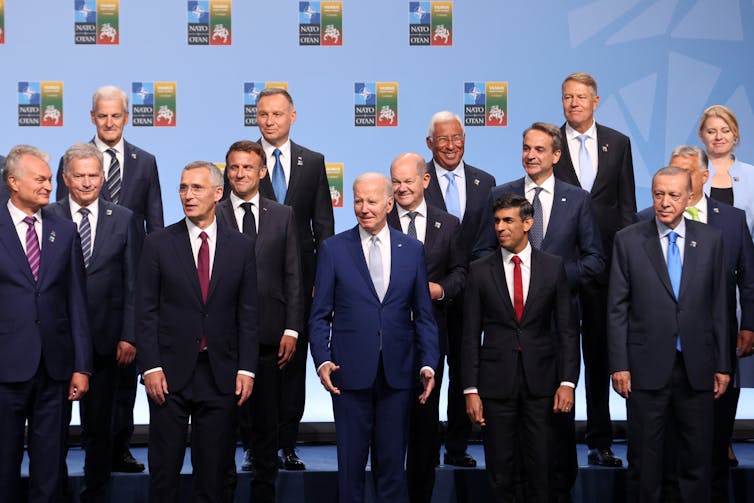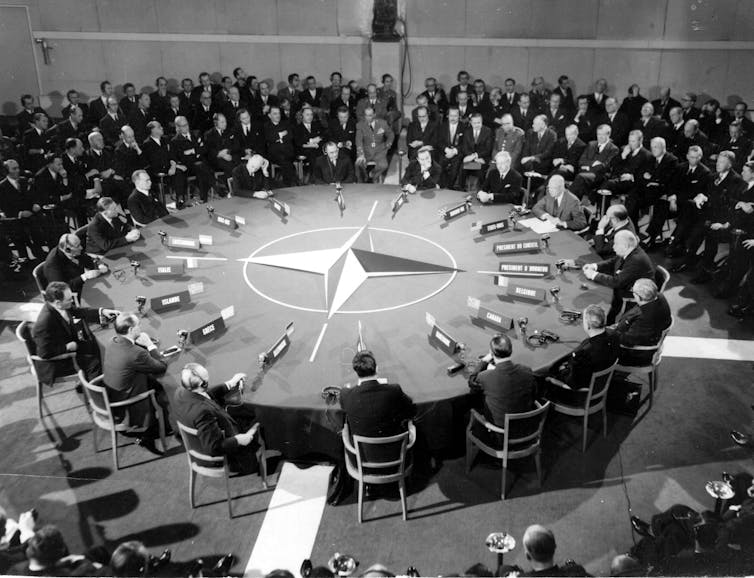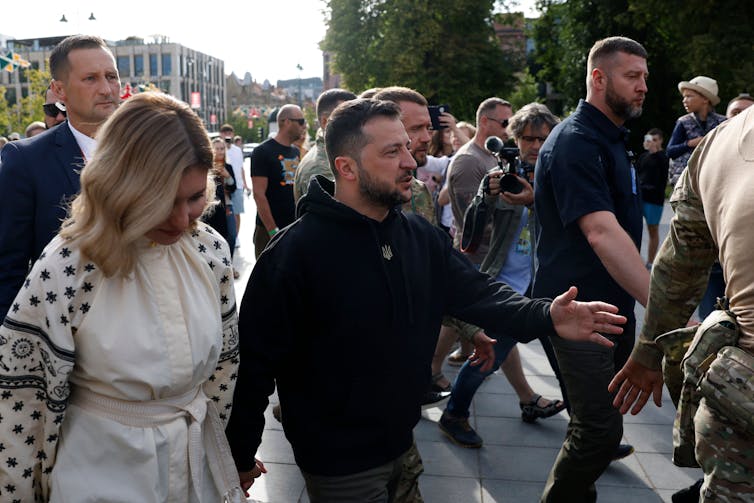
Pauline Peleckis/Getty Images
Tara Sonenshine, Tufts University
A summit is literally the highest point on the mountain. In diplomatic terms, summits like the NATO meeting, held on July 11 and 12, 2023, in Vilnius, Lithuania, mark important gatherings of world leaders.
The question of Sweden’s and Ukraine’s joining NATO, which is a political and military alliance of 31 countries from Europe and North America, was a central topic heading into this year’s summit. While Sweden is now set to join the alliance, there is no firm timeline for when countries will determine whether Ukraine is admitted.
Having worked on and attended summits as a diplomat in both the Clinton and Obama administrations, I know how much energy goes into planning the public and private diplomatic moments of these events.
NATO is convening this meeting as part of its regular work on major military and political concerns among its member countries. But make no mistake – the United States sees itself as pivotal in this summit.
For President Joe Biden, the meeting is a test of his personal commitment to help Ukraine win the battle against Russia. The U.S. has been leading a coalition of countries helping Ukraine with military and humanitarian aid. Biden has promised that the U.S. will help Ukraine “as long as it takes.”

Reg Birkett/Keystone/Getty Images
History of summits
Political leaders perfected the art of modern diplomacy in routine face-to-face summits during the darkest days of the Cold War.
Winston Churchill, at the time the U.K. prime minister, helped form the concept of a political “summit” in 1950, when he suggested a “parley at the summit.” That meant that the U.K., United States and the Soviet Union should sit down and figure out who had which sphere of influence after World War II ended.
But the history of summits stretches further back in time.
Another British politician, Lloyd George, first pushed for in-person political meetings in the early 1900s, stating, “If you want to settle a thing, you see your opponent and talk it over with him. The last thing to do is write him a letter.”
And it was the Greeks who first elevated the idea of leaders talking to leaders and debating issues as a form of building trust.
Since the Cold War, summits have taken many different shapes and sizes, ranging from regional to international meetings.
While some of these meetings result in few tangible outcomes, others have helped pave the way for key policy changes, including nuclear arms reductions in the 1980s and a treaty to limit the rise in global temperatures in 2015.
From an American perspective, summits are key moments when leadership is on display.
U.S. presidents have hosted summits on everything from democracy to trade since the Cold War. And NATO summits have taken place almost every year since the alliance’s founding in 1949.
But there is a particular level of pressure and anticipation surrounding this meeting, with an active war in Europe caused by Russia’s invasion of Ukraine in February 2022.
Backstage details
These mega-events require massive planning. Member countries can volunteer to host the summits, and the offers are evaluated and decided upon by the political branch of NATO.
From the logistical advance teams that prepare the groundwork for presidential travel to the protocol officers ensuring that handshakes or hugs are timed for photography, every detail matters both publicly and privately at these sorts of affairs.
Fashion is also a choice – from tie selection to pantsuits or dresses. Not a hair can be out of place. Women’s fashion choices tend to receive outsize scrutiny and attention – as when first lady Jill Biden wore espadrilles, a popular kind of shoe in Spain, to the NATO meeting in Madrid in 2022.
Hundreds of U.S. government officials work across multiple agencies behind the scenes at political summits, both on site and back home, to generate pages and pages of briefing materials for every minute of every hour of the meeting. Depending on the timing and importance of the summit, a secretary of state might accompany the president on the trip.
U.S. Secretary of State Antony Blinken is with Biden in Lithuania, as a delicate diplomatic dance is happening with Ukrainian President Volodymyr Zelenskyy. The Ukrainian leader has tweeted about how his country is being discussed without his presence at the meeting.
There are secure documents to be written and read and private sessions to brief Biden.
Setting the table for a summit means the host country must make literal and figurative decisions around when meals are served and who attends the dinners. The host country of a summit can show off its local cuisine, considered a form of culinary diplomacy.
Ambassadors of the other participating countries also send along menu guidelines or people’s particular dietary needs.
Expecting the unexpected
Despite all the scheduling and agenda-setting, there is an unpredictability to a political summit as people interact in real time.
Real-world events can also interfere in even a perfectly well-orchestrated summit. A terrorist incident or a natural disaster, for example, can turn a basic summit into an emergency meeting.
There are also human dynamics to summits.
It is one thing to read a briefing memo. It is quite another, as a leader, to look directly at people and see their expressions and body language.
This gives weight to closed-door meetings with just a few other people, as leaders often peel off from big group discussions to compare notes and plot strategies.
Throughout the summit, aides will pass notes to Biden, and there will be hallway huddles with diplomats and aides. Reporters will get bits and pieces of what is happening until the final press conference on July 12, at which leaders will answer questions about any decisions made, the next steps and the overall question of whether the summit was a success or failure.

Odd Andersen/AFP via Getty Images
Elevating the event
This meeting is happening in the middle of the summer. Many Europeans have flocked to beaches, as is their summer custom. Americans are off to national parks. Keeping the world’s attention on the NATO summit might be difficult. And, absent any major announcement, summits can be a humdrum affair.
But in this case, so much is riding on the NATO summit’s outcome.
Ukraine is at the center stage at this summit as countries debate extending a political invitation to Ukraine to join the alliance. Not only does NATO have to plot out its military response to an ongoing war, the U.S. and its allies have to plan for a future Ukraine once it emerges from the rubble. There is current division among NATO members whether they should admit Ukraine.
The stakes are enormous: Letting Ukraine join NATO would force the military alliance to defend its new member against Russia, which could then turn into a larger war across Europe. Hanging in the balance is the future of Russian President Vladimir Putin, whose aggression against Ukraine is really about a desire to stop the growth and power of NATO.![]()
Tara Sonenshine, Edward R. Murrow Professor of Practice in Public Diplomacy, Tufts University
This article is republished from The Conversation under a Creative Commons license. Read the original article.
















